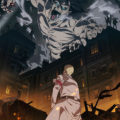Quarantine Control #48: Dear My Gargoyles in Stone

News on the COVID-19 front has been more encouraging in the last couple of weeks compared to how bad things were throughout most of 2020 and the start of 2021, thanks to cases falling and vaccinations happening. But they’ll only stay that way through everyone remaining vigilant in taking precautions to prevent spread (or respread) and take the advice of medical experts. We, unfortunately, have no shortage of morons in and outside of leadership in several countries around the world, especially the United States, which is why some governors are completely rolling back restrictions in their states. Some of them may say this is about the economy, but it’s repealing the mask mandate that makes it clear this is culture war bullshit.
It’s been nearly a year, but it’s still best to stay indoors unless you absolutely have to leave. There’s still plenty to watch and play.
Geoffrey Barnes
I decided to formally participate in the Four in February campaign this year, one that requires a commitment to playing and finishing four games by the end of February. I knew it wouldn’t be as easy as I initially thought after reading the admittedly loose rules, yet it still ended up being more challenging than I anticipated. These rules, if you want to call them that, were made just before a time when many AAA games went open world, the era where game completion times ballooned. Combine that with my desire to play RPGs and February overall being the shortest month, and I should have known I would run into some kind of problem. But game length wasn’t entirely the issue I ran into.
Sure, I started with Trials of Mana, which took me about 36 hours to complete — a week and a half with my free time. But there was no way I could complete three more games that were quite that length. This was the problem with not planning which games I would play in advance, and announcing my desire to participate in this as a spur of the moment. It left me searching my shelves (physical and digital) for games I hadn’t played yet but could be completed within a, let’s say, reasonable time. This is how I finally got around to Shovel Knight after having it on my physical shelf for years, shortly after the first time it got a retail release. I also played Blaster Master Zero, another fun NES-ish game that was considerably easier and boosted my ego. (The third game was just announced today, by the way.) By that time, I had only days left to finish a fourth game. There was perhaps too good of a game for the job.
Dear Esther: Landmark Edition (2017 — originally 2012)
Format: PlayStation 4
Episodes: It’s one short game

I’d heard about how short of a game Dear Esther was for years now, even among other “walking simulator” adventure games. It wasn’t upon finishing it that I realized just how brief it was, to the point that I wasn’t sure if it should count as a fourth game finished in February. It took me less than two hours to travel through the game’s small location, even while taking my time to either fully explore the environments for bonuses and voice quips, or to simply gawk at how good some backdrops looked. But it very much counts because it still feels like a rewarding experience by the time it ends, to the credit of the development team at The Chinese Room.
Precisely what Dear Esther is about is a mystery from the beginning. You play an old man present on a mysterious island located not far off the United Kingdom’s shores, who’s there for contemplations and lamentations. He helps weave together an explanation as to why as he explores the island, a chance for him to reminisce about memories and the traumatic events that led him back to the location. He is, as it turns out, an unreliable narrator, and the end of the story will leave a number of details unanswered. It’s up to the player to fill the blanks in themselves, through careful observations of the environment and simply thinking about what the hell they just saw and heard afterward.
Parts of the tale were vague enough to leave me thinking about what actually happened to lead to the main character’s depressed and contemplative state, which the game isn’t precise about. It wouldn’t be any fun to immediately seek out actual descriptions and theories about the mysteries (though I eventually did); it’s better to piece together everything from the main character’s narration and the peculiar-at-best environmental clues left scattered around. I’m trying to do everything I can not to delve too far into spoilers here, even though this game is over nine years old.
There’s still a part of me feeling guilty about choosing Dear Esther as the final February game, and it does feel like cheating a bit. But there are no rules for this thing, and many older games, and some new ones inspired by those older ones, can be just as short. Dear Esther also made me realize that I should play more adventure games and walking simulators, so I’ll get on that as quickly as I do everything else.
Joseph Daniels
If you subscribe to Disney+, you may have noticed the sudden appearance of a lot of content. Futurama, Burn Notice, White Collar… a lot of programming that used to be available on Netflix are now available on Disney’s streaming service. Hey, does everyone remember when we were worried about Netflix having a monopoly? We should probably be a lot more worried about Disney owning everything than we ever were about Netflix owning everything.
Speaking of Disney, want to know something that still holds up today?
Gargoyles (1994)
Source: Disney+
Episodes: 65

Wait, 78 episodes? There ain’t no 78 episodes. What are you talking about? There are 65. 65! 13 OF THOSE 78 EPISODES ARE FAKE!
Sorry, it’s been two and a half decades and I’m still not over what ABC did to the show. It should be noted that The Goliath Chronicles was never released on DVD, but that’s not as strong a statement as it should be, considering how long it took the second half of season two of Gargoyles to be released.
And actually, the original creator of Gargoyles did write the first episode of ABC’s version, so if anything, the number of canon episodes are 66, but if you want to find out Greg Weisman’s original vision for Gargoyles beyond season two, see if you can find the comics that were published by Slave Labor Graphics in the mid-2000s.
Anyway, what is Gargoyles? Way back in the 1990s, when Saturday morning cartoons were a major thing, Disney came up with their own block of animation and scheduled it for the afternoon. The Disney Afternoon aired on weekdays in the United States and Saturdays on a channel in Alberta that I was able to pick up from Revelstoke. Every year, they would shuffle the oldest television show out of the Afternoon and put something new in its place. In 1994, that new show was Gargoyles. Up until then, Disney’s animation block contained shows like Darkwing Duck, which was a superhero show that was kind of a parody of other superhero shows, especially the popular Batman: The Animated Series. The block also contained pulp adventure like Tale Spin and slice-of-life comedy like Goof Troop. Gargoyles represented a shift in tone to full on urban fantasy, and was a much more mature series than had aired before.
The Gargoyles were originally a clan who protected the humans of Castle Wyvern until they were betrayed, most of their clan smashed to bits and the rest enchanted to remain stone sculptures until one day when the castle would rise above the clouds. As far as they understood in 994AD, such a feat would be impossible without some kind of powerful magic.
A rich and eccentric man named David Xanatos bought the castle and transported it to the top of his skyscraper in New York City, fulfilling the conditions of the spell and reawakening the clan. Goliath and the rest of the Gargoyles subsequently pledged to defend New York City like they used to protect their castle a thousand years ago.
As a series, Gargoyles had above average writing and the second season contained a ton of world building, for creator Greg Weisman was trying to create an entire cinematic universe of Gargoyles on television before shared universes were ever really a thing that you did on purpose. This was before CSI came along and had three different versions airing at once, and this was before Law & Order had four simultaneous versions. Star Trek was pretty much the only series that could qualify as a shared universe during this time period, and even they reined themselves in by having only two shows in production at any one time.
I don’t know whether or not there was an overall storyline that Greg was trying to follow to its conclusion or if he was content with a more episodic format, but even with the show’s focus on individual episodes, there were still several story arcs spread throughout its two season run. Sadly, not only did The Goliath Chronicles choose a much different direction that killed the series entirely, Disney originally cancelled it after two seasons since they’d achieved the standard total of 65 episodes that meant it could be sold in syndication. Plus, this was during the height of the Disney Afternoon, when the studio continued to cycle older shows out of production to make room for new ones, regardless of how good or popular such a show was.
Incidentally, most of the Disney Afternoon’s available on Disney+ right now except for one or two shows that outright bombed. So I guess this week I’m actually recommending watching the entire Disney Afternoon. Talk about a nostalgia trip!
Angela Moseley
Dr. Stone and Dr. Stone: Stone Wars (2019, 2021)
Source: Crunchyroll
Episodes: 32 (as of this writing)

When Dr. Stone began airing in the summer of 2019, there was a lot of hype surrounding the series. My anime mutuals on Twitter were excited about the show and it also received a heavy push from Crunchyroll. Judging from the key art, I wasn’t sure what to expect. It certainly had the look and feel of an action series, but it also felt like it wouldn’t be a straight up shonen. I wasn’t sure if I’d like the show as I tried a few episodes.
Right away, I knew Dr. Stone was going to be different when the setting quickly shifted from modern day Japan to a natural paradise seemingly untainted by modern civilization. For unexplained plot reasons, every single human on Earth was exposed to a mysterious ray of light and turned into stone statues. There they sat for thousands of years until something broke Senku Ishigami free of the petrification. Before the mass petrification Senku was a genius high school student who was well versed in broad areas of science. It isn’t long before he figures out nitric acid is responsible for the de-petrifaction process that freed him from the stone. He also goes to work making rudimentary stone tools and shelter before using the fluid to revive his long-time friend Taiju Oki and later Yuzuhira Ogawa. From there Senku is determined to use the limited amount of fluid to revive more of humanity and recreate modern civilization.
The biggest roadblock to his goals is Tsukasa Shishio, a fellow high schooler Senku revived. Tsukasa is extremely intelligent and possesses immense physical strength. Within the first minute of his introduction he punches a lion to death. Ultimately, he and Senku disagree about the future of the new world. Tsukasa wants it to remain a natural paradise free of older humans; especially the type of rich old men who caused his family to suffer. He reinforces this desire by shattering the statues of older people so they can’t be revived. Senku disagrees and Tsukasa settles the issue by attempting to kill Senku.
That event eventually leads to Senku finding Ishigami Village, a group of people whose ancestors escaped the mass petrification event. In the end, he wins the village over using science and forms the Kingdom of Science. Their goal is to invent advanced tools in a stone world, take back the cave containing the nitric acid, overthrow Tsukasa, and restore the modern world. Achieving that goal is the entire crux of season two, aka Dr. Stone: Stone Wars.
Dr. Stone is an interesting mix of science based in reality, the fantastic, and lots of action when needed. The high points of the show are Senku using real-world science to solve problems. (It especially made me realize how much we modern humans don’t really think about how science and ingenuity has made our world possible—for better or worse.) Using his vast depth of knowledge it has been amazing to see Senku use the natural resources around him to recreate industrial age technology in mere months. The underlying science is real, but the power of anime means these accomplishments are made much faster than realistically possible. So yes, you still need some suspension of disbelief for the science and the larger plot of this series.
My absolute favorite aspects of Dr. Stone and Stone Wars have been the characters. Not all of them are as one dimensional as they initially appear. Senku is easy to write off as an arrogant asshole because he uses his intelligence to belittle other characters. He’s almost a villain protagonist at points. However, his better qualities become apparent. He does care about his friends and the well-being of others, even if he’s not a very warm person. He also has a rough charm wrapped in a no bullshit attitude that wins people to his side.
Additionally, other characters come around and their motivations are simple, but believable. In Ishigami village many of the characters saw first-hand how science could actively make their lives better, or enjoyed the challenge of creating new things. In the Tsukasa Empire others come around to Senku’s cause because they miss aspects of modern life or simply don’t want to see others suffer. Even Tsukasa himself isn’t completely heartless. He’s kind to his followers, even if he doesn’t show much mercy to his enemies.
As season two of Dr. Stone draws closer to an end, the long-awaited clash between Senku’s forces and those led by Tsukasa has started. While I’m sure the strength of Senku being the main character in a shonen will allow him to prevail over Tsukaska, I am curious to see how he achieves victory. Will he win more hearts and minds for Kingdom of Science? Where will the story go next? I simply can’t wait to see more.
If you haven’t checked out Dr. Stone as if yet, there’s no reason not to give it a try. It breaks the usual shonen formula in so many exciting ways.
Staying vigilant will soon get harder with so many countries and states loosening restrictions again, even though cases aren’t that low compared to how they were before the holiday season. This will only improve if we get to the point that most people in America and other countries are vaccinated by the end of May, but given how the vaccine rollout has been thus far, don’t be surprised about further stumbles along the way.





